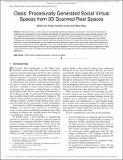Oasis: procedurally generated social virtual spaces from 3D scanned real spaces
Author(s)
Sra, Misha; Garrido-Jurado, Sergio; Maes, Patricia
DownloadSubmitted version (753.6Kb)
Terms of use
Metadata
Show full item recordAbstract
We present Oasis, a novel system for automatically generating immersive and interactive virtual reality environments for single and multiuser experiences. Oasis enables real-walking in the generated virtual environment by capturing indoor scenes in 3D and mapping walkable areas. It makes use of available depth information for recognizing objects in the real environment which are paired with virtual counterparts to leverage the physicality of the real world, for a more immersive virtual experience. Oasis allows co-located and remotely located users to interact seamlessly and walk naturally in a shared virtual environment. Experiencing virtual reality with currently available devices can be cumbersome due to presence of objects and furniture which need to be removed every time the user wishes to use VR. Our approach is new, in that it allows casual users to easily create virtual reality environments in any indoor space without rearranging furniture or requiring specialized equipment, skill or training. We demonstrate our approach to overlay a virtual environment over an existing physical space through fully working single and multiuser systems implemented on a Tango tablet device. ©2018 Keywords: virtual reality; procedural generation; multiuser interaction
Date issued
2018-12Department
Massachusetts Institute of Technology. Media Laboratory; Program in Media Arts and Sciences (Massachusetts Institute of Technology)Journal
IEEE transactions on visualization and computer graphics
Publisher
Institute of Electrical and Electronics Engineers (IEEE)
Citation
Sra, Misha, Sergio Garrido-Jurado, and Pattie Maes, "Oasis: procedurally generated social virtual spaces from 3D scanned real spaces." IEEE transactions on visualization and computer graphics 24, 1 (2018): p. 3174-87 doi 10.1109/TVCG.2017.2762691 ©2018 Author(s)
Version: Original manuscript
ISSN
1941-0506
1077-2626
2160-9306